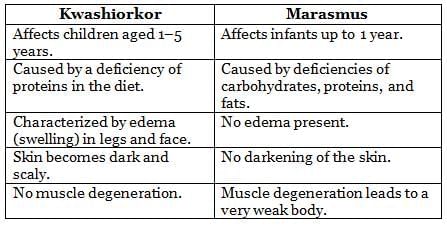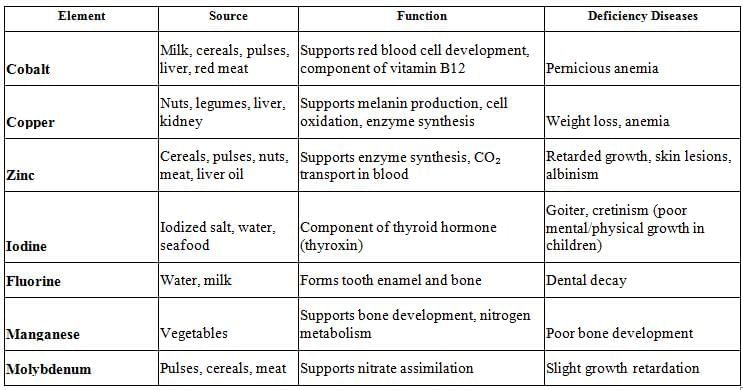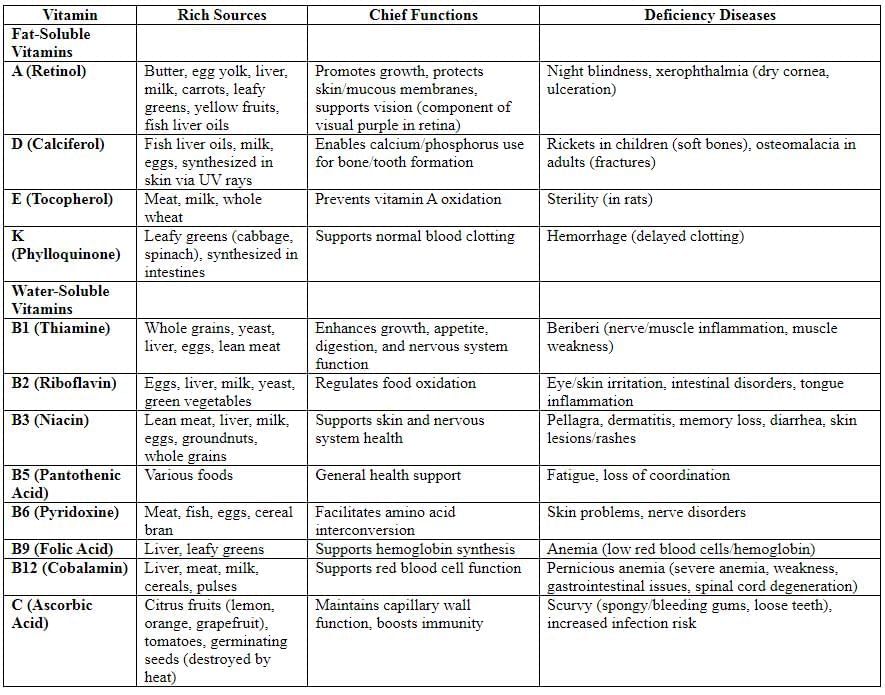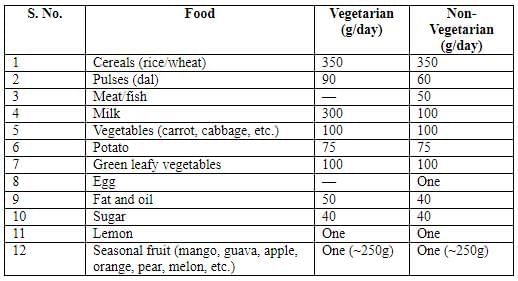Nutrition Chapter Notes | Biology Class 9 ICSE PDF Download
| Table of contents |

|
| Nutrition, Food, and Diet |

|
| Importance of Nutrition |

|
| Classes of Nutrients |

|
| Balanced Diet |

|
Nutrition, Food, and Diet
- Nutrition refers to the process of providing the body with essential organic and inorganic compounds, known as nutrients, which include proteins, vitamins, minerals, and more.
- Food encompasses any edible or drinkable substance that contains nutrients. Examples include milk, bread, eggs, fish, and apples.
- Diet is the specific combination of food items consumed during meals. A balanced diet incorporates a variety of foods that deliver all necessary nutrients. A meal is food eaten at one time to satisfy appetite (the desire to eat), while hunger is the discomfort caused by a lack of food.
Importance of Nutrition
Living organisms require food for six key reasons:
- Growth: To build new cells or protoplasm.
- Repair: To mend damaged or worn-out cells.
- Energy: To fuel bodily functions.
- Maintenance: To sustain the chemical balance of cells.
- Raw Materials: To produce secretions like enzymes, hormones, sweat, or milk.
- Protection: To bolster immunity against diseases and infections.
Classes of Nutrients
Nutrients are divided into six categories: carbohydrates, fats, proteins, minerals, vitamins, and water.
Carbohydrates
Carbohydrates, composed of carbon, hydrogen, and oxygen (with hydrogen and oxygen in a 2:1 ratio), are oxidized in cells to release energy. They include sugars, starch, and cellulose.
Sugars: Soluble and sweet, sugars are divided into:
Monosaccharides(C₆H₁₂O₆): Simple sugars that require no digestion. Examples:
- Glucose: Known as grape sugar, it’s the primary sugar in blood (blood sugar).
- Fructose: Found in plants, called fruit sugar.
- Galactose: Present in milk.
Disaccharides(C₁₂H₂₂O₁₁): Double sugars requiring digestion. Examples:
- Sucrose: Common table sugar, derived from sugarcane or sugar beets, made of glucose and fructose.
- Maltose: Malt sugar, composed of two glucose molecules.
- Lactose: Milk sugar, made of glucose and galactose.
Starch: An insoluble polysaccharide (C₆H₁₀O₅)n, stored in plants. Found in potatoes, grains (rice, maize, wheat, barley), and bread.
- Cellulose: A plant cell wall component, indigestible by humans but provides roughage to aid digestion.
- Glycogen: The storage form of carbohydrates in animals, mainly in the liver and muscles.
Carbohydrates are the body’s primary energy source (e.g., 1 mole of glucose yields 686 kilocalories).
Role of Roughage:
- Cellulose, being fibrous, absorbs water, softens fecal matter, prevents constipation, and aids intestinal movement by stimulating muscle contractions.
- Sources: Vegetables, fruits, corn, half-crushed wheat (dalia), and cabbage.
Fats
Fats, made of carbon, hydrogen, and minimal oxygen, yield high energy (1 mole releases 9.45 kcal). Sources include butter, cream, vegetable oils, meat fats, and fish liver oils. Fats consist of fatty acids and glycerol.
Functions of Fats:
- Provide energy.
- Act as a storage form of food.
- Serve as a solvent for fat-soluble vitamins.
- Insulate the body to prevent heat loss.
Proteins
Proteins are large molecules containing carbon, hydrogen, oxygen, nitrogen, and sometimes sulfur or phosphorus. Nitrogen is their key component. They are broken down into amino acids, which are essential for growth and repair.
(i) Kwashiorkor
- This severe protein deficiency disease primarily affects young children, often when breastfeeding stops early, and the child’s diet lacks sufficient protein, relying heavily on carbohydrates. Mother’s milk, rich in proteins, is replaced by starchy, protein-poor foods like fruits and vegetables.
- The term “Kwashiorkor,” from Ghana, means “the sickness the baby gets when the new baby comes,” as the older child loses access to breast milk when a sibling is born. Without adequate protein, the child may die before age five.
Symptoms of Kwashiorkor:
- Underweight
- Protruding belly
- Dark, scaly skin
- Stunted growth
- Loss of appetite
- Frequent diarrhea
- Enlarged liver and anemia
- Edema (swelling) in feet and face due to fluid buildup
Treatment:
Provide a protein-rich diet including pulses, milk, eggs, fish, and meat. A balanced diet of wheat, gram, peanuts, soybeans, and jaggery is also effective.
(ii) Marasmus:
Marasmus affects infants under one year old and results from a deficiency in carbohydrates, fats, and proteins. It often occurs after abruptly stopping breastfeeding, followed by a diet lacking energy-providing nutrients.
Symptoms of Marasmus:
- Low body weight
- Severe weakness, with a body appearing as only muscles, skin, and bones
- Loose, folded skin
- Thin face and limbs
- Delayed physical and mental growth
- Prominent ribs
Differences Between Kwashiorkor and Marasmus

Control/Treatment for Marasmus: Provide a diet rich in proteins and carbohydrates.
Mineral Salts
Mineral salts are essential in small amounts for various bodily functions. Table salt primarily provides sodium chloride, while other minerals are sourced from foods like green vegetables and fruits.
Key minerals and their roles include:
- Calcium and Phosphorus: Strengthen bones and teeth; calcium aids blood clotting, and phosphorus supports chemical processes like ATP production during cell respiration.
- Sources: Milk, meat, eggs, fish, pulses, vegetables.
- Iron: Essential for hemoglobin formation; deficiency causes anemia. Sources: Green leafy vegetables, liver.
- Iodine: Supports thyroid function; deficiency leads to goiter. Sources: Vegetables, mineral water.
- Potassium and Sodium: Facilitate cell permeability, especially in nerve cells. Sources: Most foods, table salt.
Vitamins
Vitamins are vital chemical substances required in trace amounts to maintain health, often acting as catalysts or enzymes in metabolic processes.
Each vitamin has specific functions.
Types:
- Fat-soluble (A, D, E, K): Can be stored in the body for longer periods.
- Water-soluble (B-complex, C): Cannot be stored long-term and are excreted if in excess.
- Deficiency: Prolonged lack of vitamins causes deficiency diseases.
- Role: Vitamins regulate cell metabolism in low concentrations. Excess water-soluble vitamins are easily excreted, while too much of any vitamin can be harmful.
Essential Mineral Elements in the Human Body

Water
Water constitutes about two-thirds of body weight and is essential for numerous functions:
- Acts as a solvent for organic and inorganic substances.
- Facilitates the production of digestive juices.
- Aids in transporting digested nutrients and oxygen throughout the body.
- Assists in excreting soluble wastes.
- Helps regulate body temperature.
Loss and Replacement: Water is lost through sweat, urine, and breath, requiring constant replenishment via liquids (e.g., water, beverages) and water-rich foods like fruits and vegetables. Adequate daily water intake is crucial.
Summary of Vitamins, Sources, Functions, and Deficiency Diseases

Balanced Diet Menu for an Adult with Moderate Physical Activity

Importance of Cellulose (Roughage)
Roughage, the indigestible portion of food (primarily cellulose), is found in fruits, vegetables, and seed/grain outer coats (e.g., wheat bran). It:
- Facilitates smooth intestinal movement.
- Stimulates digestive tract secretions.
- Aids in removing cholesterol and toxins.
- Prevents constipation.
Role of Nutrients in the Body
- Carbohydrates: Oxidized to release energy (heat/ATP).
- Fats: Provide energy and store nutrients.
- Proteins: Support cell/tissue building and repair, produce hormones and enzymes.
- Water, Minerals, Vitamins: Regulate bodily processes.
Balanced Diet
A balanced diet contains all essential nutrients in appropriate quantities, ensuring sufficient calories (energy measured as kilocalories, Kcal; 1 Kcal = 1000 calories). Calories raise 1g of water by 1°C.
Calorie Requirements:
- Adult laborer: 3500 Kcal/day
- Clerk: 1800–2500 Kcal/day
- Child (~6 years): 1100 Kcal/day
- Adult at rest: 1600 Kcal/day
- Woman at complete rest: 1450 Kcal/day
Malnutrition: Results from a deficiency in one or more essential nutrients, leading to weight loss, reduced work capacity, and health issues, especially during fasting when body stores are oxidized.
This rephrased content maintains the original structure and details while presenting the information clearly and concisely.
Key Points to Understand
All living organisms need food (nutrients) for growth, repair, energy, and maintenance.
The six main nutrient classes are carbohydrates, fats, proteins, mineral salts, vitamins, and water.
- Carbohydrates and fats supply energy.
- Proteins support growth and repair.
- Mineral salts are essential components of body substances.
- Vitamins perform specific vital functions.
Long-term deficiency of nutrients, particularly vitamins and minerals, leads to diseases. A balanced diet contains all essential food components in appropriate amounts.
|
18 videos|101 docs|19 tests
|
FAQs on Nutrition Chapter Notes - Biology Class 9 ICSE
| 1. What is the importance of nutrition in our daily lives? |  |
| 2. What are the main classes of nutrients, and why are they important? |  |
| 3. How can one ensure they are consuming a balanced diet? |  |
| 4. What are the consequences of poor nutrition? |  |
| 5. How does a balanced diet contribute to overall health and well-being? |  |




















